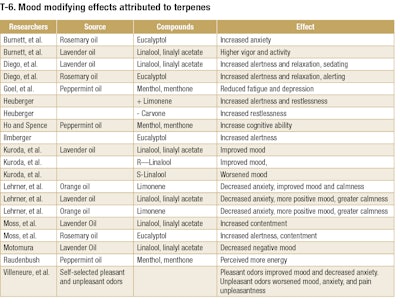
Executive Summary
Consumers are increasingly aware of terpenes and terpenoids due to their purported health effects, mood-modifying qualities and contribution to flavor. Terpenes and their derivatives are found in spices, herbs, fruits, vegetables, hops, cannabis and other sources. Flavor contributions include fruity, herbal, cooling, flavor and others. A number of health benefits have been reported in literature, such as anti-inflammation, neuroprotection, anti-cancer, anti-microbial and antioxidant. Decreased anxiety, anti-depressant, mood improvement, increased cognitive ability and increased contentment have been ascribed to terpenes.
Selection of terpenes to be used should consider regulatory issues, stability, chirality, perceived health benefits, availability and flavor/aroma. You may want to choose one or two terpenes to be highlighted due to flavor, mood or health benefits. Alternatively, a number of terpenes with the desired effects can be blended together. Essential oils and other extracts may be used to supply some or all of the terpenes. With this in mind, you can create flavors with health halos. In part one, we learned about terpenes and terpenoids, and about their reported health benefits. In part two, we look at mood management, selection of terpenes and how to put them into a finished flavor.
View part one here.
Terpenes and Mood Alteration
The demonstrated efficacy of aromas in modifying moods was reviewed by Herz (T-6).6 Aromatherapy is the use of essential oils for physical and physiological health. They claim a number of mood-modification properties of essential oils, usually applied with massages. However, the claims are often not supported and beneficial effects may be from the massage by itself. A more scientific discipline is aromachology, coined by the Sense of Smell Institute, that uses scientific analysis of the olfactory effects on mood, physiology, and behavior. Lately, most literature has been coming from the cannabis industry. For this article, we will stick to peer-reviewed literature.
Note that above, several of the physiological effects effect mood. α-Phellandrene, neurolidol, geraniol, and β-pinene, are described as anti-depressants. Other are anxiolytic (reduces anxiety), such as β-caryophyllene, α-pinene, myrcene and linalool. They can also be sedatives.

For the full article, please check out the Perfumer & Flavorist+ January 2022 issue.










